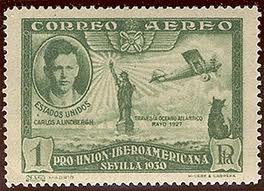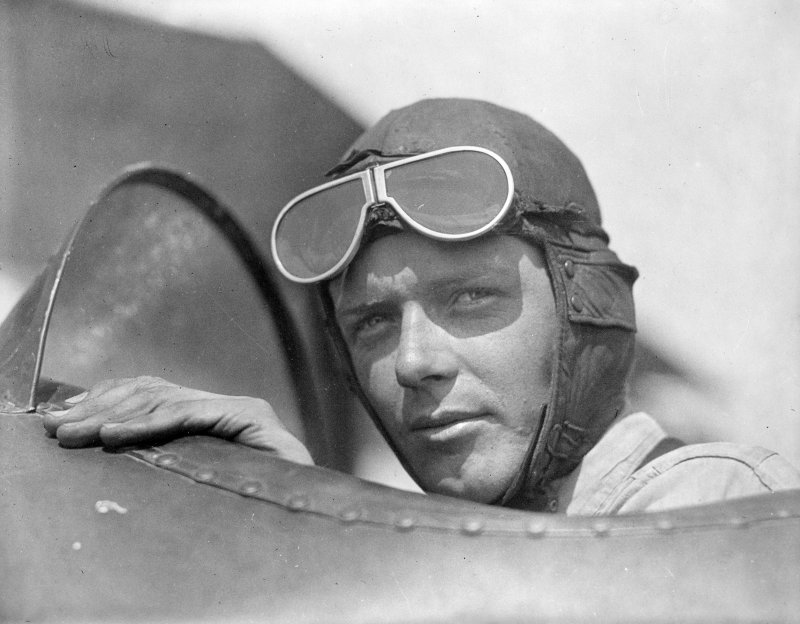Today is Charles Lindbergh Day. Had he not died in 1974 of lymphoma at the age of 72, he would have been 117. While he’s best know for his groundbreaking solo flight across the Atlantic, Lindbergh and the kitten will be the way I want to remember him.

Lindbergh was conducting a press conference before departing on his transatlantic flight and one of his mechanics handed him a kitten who had been seeking shelter in the hanger and suggested the kitty would be good company during the long flight. He responded that the flight was too cold and the kitten might die.
Contrary to other internet claims, the kitten was not his beloved pet Patsy. Just a stray who had sought warmth in the hanger. Which makes it all the more touching.
The article below, published on May 20, 1927, provides a first-hand account Lindbergh and the kitten.

The Spanish Post Office printed a postal tribute to Lindbergh’s crossing that included an image of the kitten
Here’s the unedited article put on United Press International.
MAY 20 1927
Lindbergh takes off from New York in effort to fly solo to Paris

Aviator Charles Lindbergh, wearing a helmet and goggles, is pictured in the open cockpit of airplane at Lambert Field, in St. Louis, Miss., ca. 1920s. File Photo by Library of Congress/UPI
ROOSEVELT FIELD, N.Y., May 20, 1927 (UP) — Charles E. Lindbergh, alone and without ceremony sailed off into the gray of this foggy morning in his Ryan monoplane, shouting to his friends that tomorrow he will be in Paris.
He started at 6:51 1/2 a.m. eastern standard time. When next seen this daring youngster of 25 years was flying so low over Long Island Sound, near Pt. Jefferson, NY that had he been over land, he hardly would have cleared the tree tops. At 8:40 a.m. he was sighted in Massachusetts, flying north.
His plane was wheeled from the hangar and towed from Curtiss Field to the head of the runway Commander Richard Byrd had built at Roosevelt Field and in the spirit of the Aviators’ Fraternity, had invited Lindberg to use.
Mechanics went over it for the last time and fueled the tanks. Lindbergh sought seclusion from a shower of rain in a nearby auto. He wasn’t the smiling youth of yesterday, happy with a roller coaster at Coney Island or with a toy giraffe for his hat. He was grim, nervous and his friends kept the crowd away from him. This was solemn business.
The mechanics pronounced the machine ready. Lindbergh stepped into the cockpit, looked over his cargo and came out to walk once more around the plane, trying this and that. Someone spoke of the kitten that had been given him as a mascot.
“No, don’t put him in, it will be too cold”, he pronounced. “The kitten might die.” He thus expelled his only possible living companion for the 30 to 40 hours he hoped to be flying alone in terrible monotony.
“I will be in Paris tomorrow,” he assured B.F. Mahoney, the 26-year-old president of the Ryan Airlines of San Diego, Cal, builders of Lindbergh’s plans as they exchanged a final hand shake.
Grover Whalen, Commander Richard E. Byrd and Anthony Fokker in turn wished him luck.
“I will see you in Paris,” said Byrd.
Chief of Police A.W. Skidmore of Garden City, who had become a close friend of the daring Westerner, came up.
“Well, kid, you are about to go,” he said. “If you come back you will get a good reception right here.”
“When I get into the cockpit,” answered Lindbergh slowly, “it’s like getting into a death chamber. And if I get out in Paris, it will be like a pardon from the governor.”
He climbed back into the machine, speeded his motor and looked out at the crowd that was standing silent or speaking only in whispers, all eyes intent upon this one audacious youth who sat there ready to challenge the Atlantic alone and unaided.
He turned to his controls. He glanced again at his instruments. He speeded his engine. The plane slowly began to move. The crowd cheered. Lindbergh could be seen all nervous intensity and not a sign of the smile which has been so familiar.
Gradually the machine picked up speed and rolled away. Nearly half a mile down the runway it bumped and bounced.
“He can’t make it,” men who ought to know gasped. “He is going too slow. For God’s sake, why don’t he speed up?”
Lindbergh was doing the audacious thing once more. He was moving east on the runway. If he failed to rise, he would crash into the wires and trees and houses. He could as well have gone the other way and had a clear field ahead of him; yet, it seems one of the perversities of this man to challenge fate. But Lindbergh knew what he was doing. The machine bumped heavily twice more, digging great ruts in the water-soaked and slimy mud of the runway. Then it began to rise. The crowd cheered as daylight could be seen beneath the plane. A thousand persons began running, as if they might catch up with him.
By feet, the plane rose, cleared the wires, tree tops and houses.
“God be with him,” murmured Commander Byrd.
“He’s off,” shouted the crowd.
Five planes left the ground in rapid succession and followed this lone man as he sped away.
Lindbergh’s plane grew smaller and smaller. Then its silver gray wings merged into the morning clouds.
Charles Lindbergh called “Slim” and “Lucky” by his friends was away on his supreme adventure alone.
For the next 30 to 40 hours, he hopes to sit there unable to rise, his hands on the controls, his eyes on the instruments, unable to see except thru uncertain periscopes, and with only the monotony of the restless Atlantic beneath him and the hum of his motor to hear.
A few moments later five planes, including Commander Byrd’s Fokker, were off as an escort of honor. The first to return told of Lindbergh’s passing Port Jefferson. A little later Arthur Caperton, a Curtiss flyer came back. He reported:
“He was going fast and every cylinder of his engine was hitting perfectly. He must have been making better than 100 miles an hour.”
His course took him up Long Island sound, toward the end of which the morning fogs were giving way to a bright, clear morning. Then he planned to head for Cape Race, Newfoundland, flying a straight course if weather favored it, but otherwise going out to sea or inland, high or low, wherever conditions were best.
From Cape Race, Lindbergh planned to describe a great circle, leading in a curve into the north where it might be cold and dreary and then down over Ireland, England and then to Paris.
If luck is with him, Paris will welcome the first man to fly from New York to France, sometime late tomorrow.
“I will probably go to sleep,” was Lindbergh’s promise on what he would do when and if he gets there.”












It such a great article